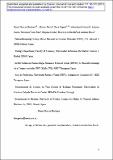Por favor, use este identificador para citar o enlazar a este item:
http://hdl.handle.net/10261/158977COMPARTIR / EXPORTAR:
 SHARE SHARE
 CORE
BASE CORE
BASE
|
|
| Visualizar otros formatos: MARC | Dublin Core | RDF | ORE | MODS | METS | DIDL | DATACITE | |

| Título: | The costal remains of the El Sidrón Neanderthal site (Asturias, northern Spain) and their importance for understanding Neanderthal thorax morphology |
Autor: | García-Martínez, Daniel CSIC ORCID; Bastir, Markus CSIC ORCID ; Huguet, Rosa CSIC ORCID; Estalrrich, Almudena CSIC ORCID; García-Tabernero, Antonio CSIC ORCID; Ríos, Luis; Cunha, Eugenia; Rasilla, Marco de la; Rosas, Antonio | Palabras clave: | Virtual reconstruction Rib cage Ribs Geometric morphometrics Fossils Evolution |
Fecha de publicación: | oct-2017 | Editor: | Elsevier | Citación: | Journal of Human Evolution 111: 85-101 (2017) | Resumen: | [EN] The study of the Neanderthal thorax has attracted the attention of the scientific community for more than a century. It is agreed that Neanderthals have a more capacious thorax than modern humans, but whether this was caused by a medio-lateral or an antero-posterior expansion of the thorax is still debated, and is key to understanding breathing biomechanics and body shape in Neanderthals. The fragile nature of ribs, the metameric structure of the thorax and difficulties in quantifying thorax morphology all contribute to uncertainty regarding precise aspects of Neanderthal thoracic shape. The El Sidrón site has yielded costal remains from the upper to the lower thorax, as well as several proximal rib ends (frequently missing in the Neanderthal record), which help to shed light on Neanderthal thorax shape. We compared the El Sidrón costal elements with ribs from recent modern humans as well as with fossil modern humans and other Neanderthals through traditional morphometric methods and 3D geometric morphometrics, combined with missing data estimation and virtual reconstruction (at the 1st, 5th and 11th costal levels). Our results show that Neanderthals have larger rib heads and articular tubercles than their modern human counterparts. Neanderthal 1st ribs are smaller than in modern humans, whereas 5th and 11th ribs are considerably larger. When we articulated mean ribs (size and shape) with their corresponding vertebral elements, we observed that compared to modern humans the Neanderthal thorax is medio-laterally expanded at every level, especially at T5 and T11. Therefore, in the light of evidence from the El Sidrón costal remains, we hypothesize that the volumetric expansion of the Neanderthal thorax proposed by previous authors would mainly be produced by a medio-lateral expansion of the thorax. [ES] El estudio del tórax Neandertal ha atraído el interés de la comunidad científica por más de un siglo. Existe acuerdo acerca de la mayor capacidad torácica en Neandertales en comparación con humanos modernos. Sin embargo, si esto es causado por una expansión antero-posterior o medio-lateral del tórax es debatido a día de hoy y es clave para el entendimiento de la biomecánica respiratoria y la morfología corporal en Neandertales. La frágil naturaleza de las costillas, la estructura metamérica del tórax y las dificultades en la cuantificación morfológica contribuyen a la incertidumbre en referencia a aspectos de la morfología torácica Neandertal. El yacimiento de El Sidrón ha proporcionado elementos costales que comprenden desde el tórax superior hasta el inferior, así como diferentes restos costales proximales (frecuentemente ausentes en el registro fósil Neandertal), los cuales pueden arrojar luz sobre esta incertidumbre. Nosotros comparamos las costillas de El Sidrón con costillas de humanos modernos actuales, así como con humanos modernos fósiles y otros Neandertales, a través de técnicas de morfometría clásica y morfometría geométrica 3D, combinadas con técnicas de estimación de datos perdidos y de reconstrucción virtual (a nivel de 1a, 5a y 11a costilla). Nuestros resultados muestran que los Neandertales presentan cabezas costales y tubérculos articulares más grandes que humanos modernos. A nivel de tamaño global de las costillas, las 1a costillas Neandertales son más peque~nas que las de humanos modernos, mientras que las 5a y 11a son considerablemente más grandes. Cuando articulamos costillas medias (forma y tamaño) con sus correspondientes elementos vertebrales, nosotros observamos que el tórax Neandertal presenta una expansión medio-lateral en los diferentes niveles estudiados con respecto a humanos modernos, aunque esto es más evidente a nivel T5 y T11. Por lo tanto, a la luz de la evidencia proporcionada por los restos costales de El Sidrón, nosotros hipotetizamos que la expansión volumétrica Neandertal propuesta por autores previos, debería ser fundamentalmente producida por una expansión medio-lateral del tórax. |
URI: | http://hdl.handle.net/10261/158977 | DOI: | 10.1016/j.jhevol.2017.06.003 | Identificadores: | doi: 10.1016/j.jhevol.2017.06.003 issn: 0047-2484 |
| Aparece en las colecciones: | (MNCN) Artículos |
Ficheros en este ítem:
| Fichero | Descripción | Tamaño | Formato | |
|---|---|---|---|---|
| POSTPRINT JH Evol 111 85-101 (2017).pdf | 1,11 MB | Adobe PDF |  Visualizar/Abrir |
CORE Recommender
SCOPUSTM
Citations
24
checked on 11-may-2024
WEB OF SCIENCETM
Citations
22
checked on 29-feb-2024
Page view(s)
611
checked on 14-may-2024
Download(s)
548
checked on 14-may-2024
Google ScholarTM
Check
Altmetric
Altmetric
Este item está licenciado bajo una Licencia Creative Commons

